Tongue is an important organ involved in the functions of speaking, chewing and swallowing. It also contains taste buds that cover the upper surface of the tongue.
A variety of disorders and diseases can affect the tongue including :
- Congenital disorders
- Infections
- Chronic irritation
- Abnormal tissue growth
Developmental (Congenital) Disorders
Most developmental disorders of the tongue are related to its size and shape, though structural defects also exist.
Some of the more common developmental disorders are
- Microglossia
- Macroglossia
- Ankyloglossia
- Fissured tongue
Microglossia
This is a rare developmental condition characterised by an abnormally small tongue. This condition will cause some difficulties related to speech and swallowing. There is no treatment for this condition.
Macroglossia
Macroglossia is a condition where the tongue is abnormally enlarged. This is a much more common condition than microglossia.
Macroglossia may be
- Developmental or
- Associated with other conditions like a tumour of the tongue, hemangioma, acromegaly or amyloidosis
Macroglossia can cause spacing of the teeth due to continuous pressure exerted by the large tongue. The treatment of macroglossia involves the removal of the cause that gives rise to the condition. In the case of developmental macroglossia, surgical stripping of the tongue is sometimes advised.
Ankyloglossia
Ankyloglossia is a developmental disorder more commonly known as tongue tie. This condition occurs because of the fusion of the lingual frenum to the floor of the mouth. This usually leads to speech problems.
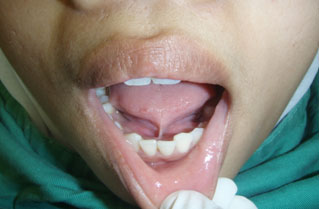
Ankyloglossia (tongue tie)
Treatment is indicated only if the condition is causing a problem. If no symptoms are experienced, only monitoring is advised. The treatment is to surgically relieve the connection between the frenum and the floor of the mouth.
Fissured tongue
This is a quite common developmental abnormality. Also known as scrotal tongue (the appearance of the tongue often resembles scrotum). This abnormality may also present in people with Down’s syndrome or Melkersson-Rosenthal syndrome. Clinically, multiple grooves (fissures) are present on the surface of the tongue.
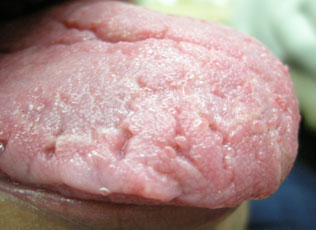
Fissured tongue
The condition is usually painless and requires no treatment. Nevertheless, gentle brushing of the tongue is advised to remove trapped food and bacteria.
Median Rhomboid Glossitis
Median Rhomboid Glossitis is a lesion on the posterior midline of the tongue strongly associated with fungal infection (Candida albicans). This condition is reportedly more common in men. Some predisposing factors include
- Smoking
- Denture wearing
- Corticosteroid sprays / inhalers
- HIV infection
The lesion may be flat or nodular and usually have rhomboidal shape. Clinically, the lesion appears as
- Smooth
- Erythematous (red) and
- Plaque-like
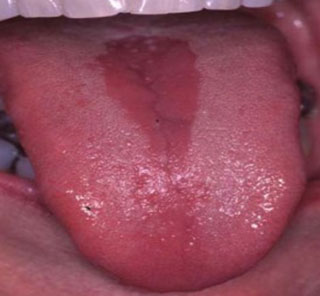
Median rhomboid glossitis
Most patients are asymptomatic. Some lesions resolve with antifungal therapy, although most lesions will only show partial resolution. Patients are advised to stop smoking.
Geographic Tongue
This condition is also known as benign migratory glossitis. The etiology is unknown. Clinically, the lesion appears as smooth red area surrounded by raised irregular yellowish borders. The red areas may regress spontaneously, but reappear over time.
They tend to migrate from one area to another (hence ‘migratory’) and change in size and shape, resembling a map (hence ‘geographic’). Other parts of oral mucosa may also be affected. Often it is an incidental finding during routine dental check-up.
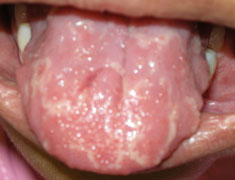
Geographic Tongue
Most patients are asymptomatic. The condition usually requires no treatment except reassurance. Occasionally, some patients may experience sensitivity/burning sensation to hot or spicy foods. Topical steroid gels and/or antiseptic mouth rinses may be prescribed to such patients.
Coated/Hairy Tongue
The coated/hairy appearance of the tongue is caused by accumulation of excess keratin on the filiform papillae (top surface) of the tongue. The difference between coated and hairy tongue is that of the degree of keratin accumulation. In coated tongue, the accumulation is not severe and may appear as white plaque. In hairy tongue, the amount of keratin is more and that gives the appearance of fine hair-like projections on the top surface of the tongue.
The lesion may appear black/brown in color due to tobacco (in smokers) or coffee/tea staining. The tongue could also appear yellowish-white if food debris and bacteria is trapped within these papillae.
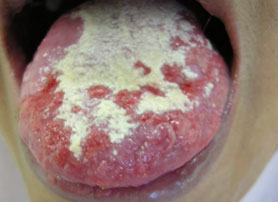 |
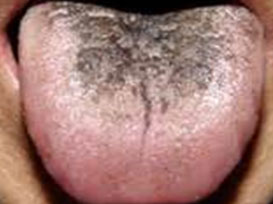 |
| Coated tongue | Hairy tongue |
Most patients are asymptomatic, but some may experience halitosis (bad breath). No treatment is required, except gentle daily debridement with tongue scraper or soft toothbrush to remove the excess keratin.
Other Tongue Abnormalities
Other abnormalities of the tongue include swellings caused by:
- Vascular lesions
- Tumours
- Infections
- Other rare causes such as amyloidosis
And ulceration, caused by:
- Recurrent aphthous stomatitis
- Viral (herpes simplex virus) or bacterial infections (tuberculosis & syphilis)
- Vesiculo-bullous diseases such as pemphigus, pemphigoid and lichen planus
- Tumours
References
- Gonsalves WC, Chi AC, Neville BW. Common oral lesions: Part 1. Superficial mucosal lesions. Am Fam Physician. 2007; 75(4): 501-7.
- Reamy BV et al. Common tongue conditions in primary care. Am Fam Physician. 2010; 81(5): 627-34.
- Scully C. Oral and Maxillofacial Medicine. Elsevier; 2001: 276.
- Scully C, Porter S. Orofacial Disease: Update for Dental Clinical Team: 6. Complaints affecting particularly the lips or tongue. Dent Update. 1999; 26: 254-9.
| Last Reviewed | : | 20 March 2015 |
| Writer | : | Dr. Sumairi b. Ismail |
| Accreditor | : | Dr. Nurshaline Pauline bt. Hj. Kipli |
| Reviewer | : | Dr. Ajura bt. Abdul Jalil |







